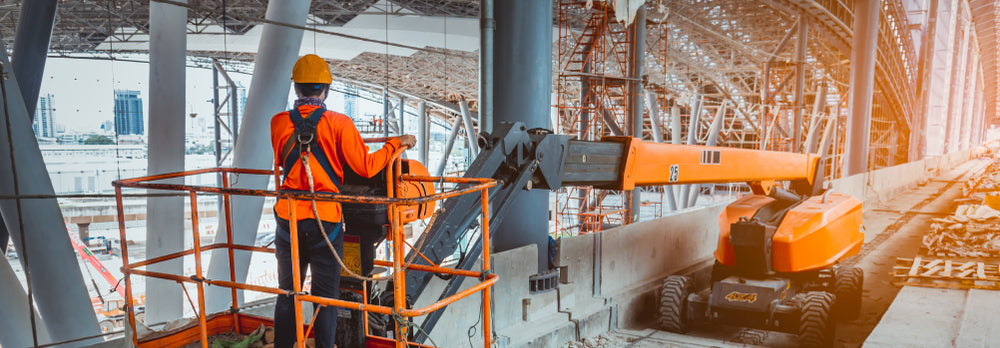Working at heights is a tricky business. You must elevate yourself and your fellow workers to the desired height while also remaining safe. Some construction companies use scaffolding to accomplish this, but aerial lifts are also a popular means of elevation. Aerial lifts are any vehicle-mounted devices with extendable platforms used to raise workers.
Sometimes called boom platforms, they include extendable boom platforms, aerial ladders, articulating (jointed) boom platforms, vertical towers, and any combination of these. Aerial lifts are great for working on roofs, and they can be a great alternative to scaffolding and ladders because of their mobility and flexibility. They can be made of metal, fiberglass-reinforced plastic, or other materials, and they can be power or manually operated.
Aerial lifts are beneficial machines when working at heights, but inherently, there is a safety risk. Every year, aerial lift accidents account for 3% of construction deaths. Workers have fallen, been struck by objects, been ejected from the platform, and more. It is imperative that you and your team are ready and prepared to use your aerial lift safety.
Training for Aerial Lifts
The most crucial step to operating an aerial lift happens even before you step on it. Proper training is required to operate an aerial lift. Retraining is also required if an accident occurs on an aerial lift, a workplace hazard is discovered, or a different type of aerial lift is used. Training and retraining may seem like a hassle, but it can help you maintain a safe work environment.
Training must include…
- Hazard procedures
- Explanations of all hazards: electrical, fall, falling objects, etc.
- Identifying and avoiding unsafe conditions or hazards
- Instructions for operation of lift
- Instruction on maximum intended load and capacity
- Demonstrations of aerial lift knowledge and skills
- Inspection procedure and timeline
- Manufacturer’s requirements
Safely Using an Aerial Lift
There are many ways to maintain safety while using an aerial lift, but you cannot go without inspections and fall protection. Those are two essential components to maintaining safety on an aerial lift.
Before each work shift, you must inspect your aerial lift to certify it is in safe, working condition. Always follow the manufacturer’s recommendations. You need to inspect the vehicle components and the lift components. It is also essential to check that the lift is working before putting any workers or supplies on it.
Items to inspect and look for:
- Proper fluid levels
- Leaks
- Wheels
- Battery and charger
- Lower-level controls
- Horn, gauges, lights and back up alarms
- Steering and brakes
- Operating and emergency controls
- Hydraulic, air, pneumatic, fuel, and electrical systems
- Fiber glass and other insulating components
- Missing or unreadable markings
- Mechanical fasteners and locking pins
- Cable and wiring harnesses
- Outriggers ,stabilizers and other structures
- Loose or missing parts
- Guardrail systems
After inspecting your aerial lift, inspect the surrounding work zone to ensure there are no hazards present. You want to check above, guaranteeing there are no hazards, such as electrical wires or if indoors, no low ceilings. Below, check for an unsafe surface, including loose soil, drop-offs, holes, ditches, slopes, debris, or anything else that make create a dangerous situation. Finally, be sure to check the weather. Using an aerial lift during thunderstorms, hail, or other severe weather is incredibly unsafe.
The other essential component of safety is fall protection. Fall protection is critical when using an aerial lift. OSHA requires you to wear a body belt with a lanyard attached to the boom when working on an aerial lift. It doesn’t matter what height you are at, what job you are performing. OSHA requires fall protection at all times on an aerial lift. It is important to note that body belts are the bare minimum requirement. They prevent falls, but the best option is to use a personal fall arrest system.
We have compiled a shortlist of do’s and don’ts while operating a list. Make sure to bookmark this page, so you can double-check that you are prepared for using your aerial lift.
|
Do’s |
Don’ts |
|
Use outriggers, brakes, and wheel clocks for added stability |
Don’t override hydraulic, electrical or mechanical safety features |
|
Use fall protection |
Don’t surpass weight or height limits |
|
If you must work near electrical wires, always be aware of them |
Don’t climb, sit, or lean against the edge of the platform |
|
Ensure everyone is trained |
Don’t put scaffolding on an aerial lift |
Thank you for reviewing aerial lift safety with us today. Aerial lifts provide some much convenience to us in the construction business, but we need to remember to use them safely and cautiously. Please share below any of your aerial lift stories: How have they helped you? Do you have any tips?
Wishing you a happy and safe workplace,
- The WRYKER Safety Team

